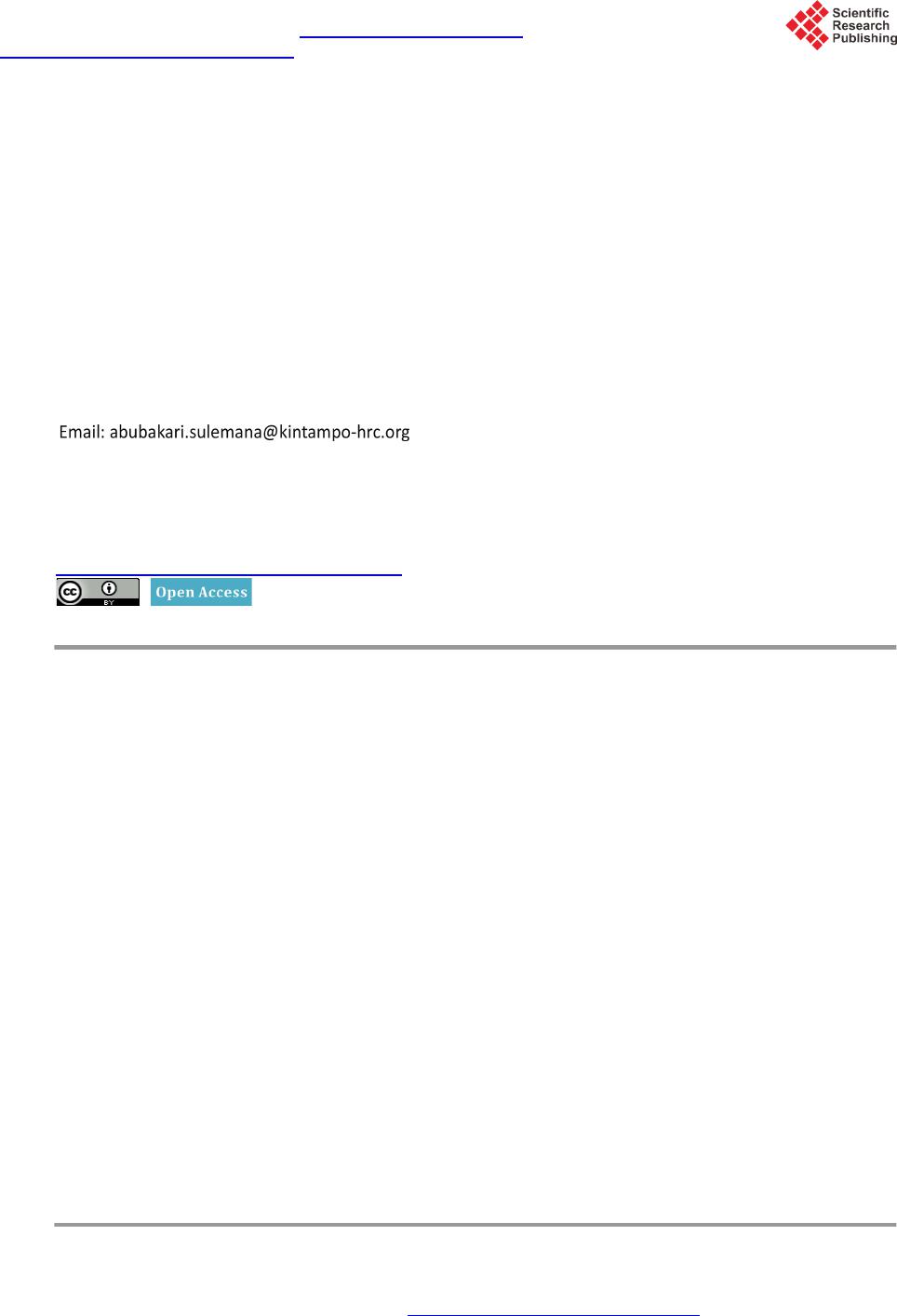 Open Journal of Social Sciences, 2015, 3, 239-249 Published Online November 2015 in SciRes. http://www.scirp.org/journal/jss http://dx.doi.org/10.4236/jss.2015.311029 How to cite this paper: Abubakari, S., et al. (2015) Adolescents’ Willingness and Intentions to Use Contraceptives in Rural Ghana. Open Journal of Social Sciences, 3, 239-249. http://dx.doi.org/10.4236/jss.2015.311029 Adolescents’ Willingness and Intentions to Use Contraceptives in Rural Ghana Sulemana Abubakari, Yeetey A. Enuameh, Emmanuel Mahama, Obed Ernest A. Nettey, George Adjei, Gifty Fosuaa Nuamah, Edward Apraku Anane, Robert Adda, Francis Dzabeng, Seeba Amenga-Etego, Charles Zandoh, Kwaku Poku Asante, Seth Owusu-Agyei Kintampo Health Research Centre, Kintampo, Ghana Received 19 October 2015; accepted 16 November 2015; published 19 November 2015 Copyright © 2015 by authors and Scientific Research Publishing Inc. This work is licensed under the Creative Commons Attribution International License (CC BY). http://creativecommons.org/licenses/by/4.0/ Abstract Efforts made to improve the availability and access to family planning services to adolescents in Ghana have not yielded the desired results. Adolescents in the Kintampo Health and Demographic Surveillance System area are no exception. This study explored contraceptive use intentions, pre- ferences and their determinants among adolescents in rural Ghana. This was to contribute evi- dence towards achieving universal access to reproductive health. A cross-sectional study design was used to collect Sexual and Reproductive Health data in the Kintampo districts in 2011. A total of 1805 female adolescents were randomly sampled from a resident female adolescent population of 16,795. This study used intention and/or willingness of adolescents to use contraceptives as the outcome variable and the explanatory variables were demographic and socio-economic factors. Descriptive and inferential statistical analyses were done. The findings indicated 54.3% of adoles- cents’ were willing to use contraceptives. Injectable was the most preferred contraceptive method among adolescents (48.6%); this was followed by the pill (29.6%) with the least being foam or jelly (0.2%). The most commonly cited reason for not intending to use contraception was adoles- cents’ opposition to family planning (31.5%) followed by a fear of side effects (25.8%). Age and education influenced adolescents’ willingness to use contraceptives in the future. Formal educa- tion of the young generation coupled with knowledge of contraceptive methods could yield posi- tive outcomes for contraceptive use and ultimately reproductive health of the adolescent popula- tion in the near future. Keywords Kintampo, Ad olesce nt, Co ntracept ive, Edu cation, Gh an  S. Abubakari et al. 1. Introduction Adolescent females aged 15 - 19 years account for over 14 million births each year, 91 percent of those from low and middle-income countries (LMICs) [1]. Six million ado lescent pregnancies are unintended and occur in the context of low contraceptive prevalence [2] [3]. Less than one third of currently married adolescent females in LMI C s who wa nt to a vo id a p r egnancy use a modern method of contraception, and more than 60 percent who would like to avoid or delay pregnancy are not able to do so [4]. Sexual activity of adolescents outside of mar- riage is increa sing, but l ess than half o f those who want to avoid pregnanc y are usi ng a mode rn metho d of co n- traception [4]-[6]. Adolescence is the period between the ages of 10 and 19 years when young individuals transit into adul thood [7] [8]. This period is subdivided into early (10 - 14 years) and late (15 - 19 years) adolescence [9] or early (10 - 13 years), mid- (14 - 15 years) and late (16 - 19 years) adolescence [10] [11]. As per the 2010 population census, adolescents constitute a fifth (22.4%) of the total population of 24.7 million people in Ghana [12]. In the Kin- tampo districts covered by the Kintampo Health and Demographic Surveillance System (KHDSS), adolescents also make up a fifth (20.2%) of the population [13]. Within the p ast one and half decades, several efforts have been made to make available and accessible sexual and reproductive health (SRH) services to adolescents. Despite these efforts, adolescents still face a number of SRH problems [11]. The birth rate of 15 - 19 year old adolescents in West and Central Africa is estimated as 128 per 1000—more than twice the world average of 50 [14]. These births put female adolescents at a high risk of death or lifelong complications, because they are still not well developed to start child bearing. Many adoles- cents with unwanted pregnancies tend to go for unsafe abortions due to limited availability and high cost of abortion services. Unsafe abortions contribute significantly to the high rates of morbidity and mortality among young female s [14]. According to the 2008 Ghana Demographic and Health Survey (GDHS) about 14% of all Ghanaian female adolescents have started child bearing, with only 8.0% of them using contraceptives [15]. The United Nations Population Fund (UNFPA) also reports that, sub-Saharan Africa has the lo west demand (30%) and use (20%) of contraceptives among 15 - 19 year o ld s. They fur t he r c o mm e nt that poor access to family planning (FP) services and negative attitudes of health workers towards adolescent contraceptive use have contributed to high rates of pregnancies among adolescent [16]. This study sought to explore contraceptive use intentions and preferences among female adolescents in two predominantly rural districts in Ghana. The study also examined the factors associated with adolescents’ will- ingness to use contraceptives in the study population. This would contribute evidence towards improving the health of adolescents and meeting MDG 5b of achieving universal access to reproductive health by 2015. This target has been described as the most underachieved of all MDGs [17]. 2. Methods 2.1. Study Area The Kintampo Health Research Centre (KHRC) administers the KHDSS, which covers the Kintampo North Muni cipal ity and the South Distric t in the Brong Ahafo Region of Gha na. T he districts are mainly rur al and the ir capitals, Kintampo and Jema, are semi-urban [18]. The districts had an estimated population of about 143,287 as at December 2011 [13]. The KHDSS routinely conducts updates on the entire population by collecting data on births, deaths and migrations as well as other demographic and health i nformation. 2.2. Study Design, Sampling and Data Collection The KHDSS conducted a SRH sur ve y ( cr o ss -sectio nal stud y de sign) fro m Jul y to Dece mb er 2 011. Details of the sampling procedure for the SRH survey is published elsewhere [19]. Data for this manuscript was drawn from information gathered with the female SRH data collection tool. A sample of 1,805 females aged 10 to 19 was randomly selected from a resident female adolescent population of 16,795 within the KHDSS as of July 2011 [13]. As shown in the Appendix, a structured questionnaire consisting of close-ended questions was used in the course of the survey. The questionnaire enquired from respondents’ whether they will use a contraceptive method to delay or avoid pregnancy at any time in the future. Respondents who responded “yes” were further  S. Abubakari et al. asked which contraceptive method they preferred to use. On the other hand, those who responded “no” were furt her asked the mai n reaso n for no t wantin g to use a contrac eptive method . In add ition, respo ndents who gave their reason as not being married were further asked whether they would ever use a contraceptive method if they were married. Questionnaires were administered by trained fieldworkers, and interviews were conducted in pri- vacy at the respondent’s place of residence. Interviews were done one-on-one with the respondents in the local language. Fieldworkers briefly introduced the study. They translated the questions in the same way to ensure consi stency. One question was asked at a time and the y followed through the instr uctions o n the questionnaire. 2.3. Data Management and Analyses Field supervisors checked all the forms manually for completeness and consistency. Range and consistency checks were performed and the forms were double entered on computers using Microsoft visual FoxPro (version 9.0) data management software. Discrepancies were resolved by reference to the original for ms and field manual, which was used for training the data collectors. Data analyses were performed using STATA version 11.2 [20]. Socio-demographic characteristics of respondents that were categorical in nature were summarized as propor- tions while continuous variables were summarized as means based on the nature of the di stribution. Background information including age, highest educational level attained, marital status and household assets of study sub- jects was extracted from the KHDSS database. The outco me varia bles o f inte rest i n this stud y were t he inte ntion and/or willingness of adolescents to use contraceptives, as well as adolescents preferred contraceptive and the main reasons for not using contraceptives. Explanatory variables of interest were demographic and socio-eco- nomic factors of age, highest educational attainment, household wealth quintile, ethnicity, religion, occupation, place of residence (rural/urban) and district of residence. Household asset data was used to determine the ho use- hold wealth quintile (i.e. using the Principal Component Analysis) to serve as a proxy for socio-economic status. The categories of the wealth quintile were most poor, more poor, poor, less poor and least poor. Univariate and Multivariate logistic regression models were used to identify respondent characteristics that predicted willing- ness of adolescents to use contraceptives. 2.4. Ethical Review Prior approval for the study was obtained from the KHRC Institutional Ethics Committee. Respondents were primed and educated on the sensitive issues envisaged in the questionnaire to reduce any uneasiness that could be related to providing in for mation o n SRH is sues. P articipants who voluntarily signed o r thumb printed an in- formed consent or assent for m after the study was explained to them were interviewed. The parents or guardians of persons less than 18 years consented after the minors have give n their assent. As part of measures to ens ure confidentiality, the data is securely stored at the KHRC data bank and only authorized KHRC personnel are pro- vided access. 3. Results 3.1. Socio-Demographic Characteristics of Respondents The findings in this section were based on data captured in Table 1. A total of 1,421 female adolescents were included in this study after data cleaning. They were categorized into early (10 - 13 years), mid- (14 - 15 years) and late (16 - 19 years) adolescence. About one quarter (24.8%) of the respondents were aged 10 - 13, a little over a fifth (20.4%) were 14 to 15 years and more than half (54.8%) were 16 to 19 years. Less than a fifth of the adolescents (15.6%) had no formal education. Almost half (47.9%) had primary education, over a fifth (23.2%) had completed middle or junior high school and 13.3 percent had completed senior high school or tertiary edu- cation. Most adolescents (86.4%) were single at the time of the survey. The Northern tribes constituted half (49 .8%) of the ethnic groups in the study population, followed by the Akan (22%), the Mo (12 percent) and other tribes (16.2%). Over half (55.2%) of the respondents belonged to the Christian faith, while close to a third (27.7%) were Muslims. Close to a third of the respondents (32.4%) were not employed. About two-thirds (63 percent) of the respondents were from rural communities and twenty three percent (22.5%) belonged to the least poor households.  S. Abubakari et al. Table 1. Socio-dem og r a phic and economic characteristics of respondents (N = 1,421). Characteristics Number % Age of re s pondents 10 - 13 352 24.8 14 - 15 290 20.4 16 - 19 779 54.8 Educational level No education 221 15.6 Primary 680 47.9 Midd le/J HS 331 23.2 SHS and above 189 13.3 Ethnicity Akan 312 22.0 Mo 171 12.0 Northern 707 49.8 Oth er 231 16.2 Religion Chr ist ian 785 55.2 Mos lem 393 27.7 Other religion 107 7.5 Not known 136 9.6 Occupation Not em ployed 461 32.4 Employed 34 2.4 Farmer, labourer, domestic 101 7.1 Min or 688 48.4 Not known 137 9.7 Marital status Married 21 1.5 Livin g together 172 12.1 Sin gle 1 228 86.4 Pla ce of r esidence Rural 906 63.8 Urban 515 36.2 Hous e h old we a lth quinti les Most poor 258 18.1 More poor 260 18.3 Poor 280 19.7 Less poor 304 21.4 Least p oor 319 22.5  S. Abubakari et al. 3.2. Adolesce nt s’ Willingness to Use Contraceptives at the Time of the Study As sho wn in Table 2(a), about six (62.4%) out of ten of the late adolescents were willing to use contraceptives to delay or avoid pregnancy compared to about five (51.2%) and four (38.8%) out of ten for the mid and early adolescents respectively. More ado lescents with no education compared to those with some education were un- sure of current use, as were those with northern ethnic background compared to other ethnic groups. A lot more adolescents residing in rural communities compared to those in urban said they were unsure of using contracep- tives as at the time of the survey. Table 2 . Adolescents future contraceptive use intentions and willingness to use contraceptive to delay or avoid pregnancy by socio -demographic and economic characterist ics. Soc io -demographic and economic variable a. Willingness of adolescents to use contraceptive to delay or avoid pregnancy (N = 1395) b. Intention of adolescents to use contraceptives if they were married (N = 223) Not known 68 (52.3) 53 (40.8) 9 (6.9) 5 (17.2) 19 (65.5) 5 (17.2)  S. Abubakari et al. 3.3. Adolesce nt s’ Intention to Use Contraceptives in the F uture Adolescents’ intention to use contraceptives in future as shown in Table 2(b) follows a similar pattern to their willi ng ne s s to u se co ntr ac ep t i ves a t the t i me o f the s ur ve y s ho wn i n Ta ble 2 (a). Ab o ut fo ur o ut of ten of t he l at e adolescents intended to use contraceptives when they got married. For the early and mid-adolescents, about one and two respectively out of ten intended to use contraceptives when they were married. More of the early ado- lescents (31.5%) compared to the mid (15.6%) and late (14.3%) adolescents did not know whether they would use contraceptives when they got married. More adolescents with no education compared to those with some education were not certain of their intention to use contraceptives. Also, more adolesc ents of no rthern ethn icity compared to other ethnic groups did not know whether they would use contraceptives in the future. Furthermore, more Muslim adolescents compared to other religions were uncertain of their intention to use contraceptives in the future. Adolescents residing in rural communities (22.6%) compared to those in urban (10.9%) did not know whether they intended to use contraceptives. 3.4. Adolesce nt s’ Preferred Contraceptive Methods Injectables were the most preferred contraceptive method among adolescents (48.6%); this was followed by the pill (29.6%) with the least being foam or jelly (0.2%) as shown in Table 3(a). However, the early adolescents equally liked the injectables and the pills, 43.4% apiece. On the other hand, 47.1% and 28.1% of the mid ado- lescents would prefer to use the injectables and the pills respectively while 50.1% and 26.9% of the late adoles- cents would prefer to use the injectables and the pills in that order. Table 3. Adolescents prefer r ed contraceptive methods and main reasons for not using contraceptive method by age-group. a. Preferred contraceptive method (N = 663) Age-group (%) 10 - 13 14 - 15 16 - 19 Total Female sterilization 2 (2.0) 4 (3.3) 3 (0.7) 9 (1.4) IUD 0 (0.0) 1 (0.8) 6 (1.4) 7 (1.1) Male condom 0 (0.0) 4 (3.3) 23 (5.2) 27 (4.1) Form/Jelly 0 (0.0) 0 (0.0) 1 (0.2) 1 (0.2) b. Main reasons for no t intending to use contracepti ve method (N = 476) 10 - 13 14 - 15 16 - 19 Total Others opposed 0 (0.0) 1 (0.9) 2 (0.9) 3 (0.6) Cost too much 0 (0.0) 0 (0.0) 1 (0.4) 1 (0.2) Tota l 139 (100.0) 107 (100.0) 230 (100.0) 476 (100.0)  S. Abubakari et al. 3.5. Adolesce nt s’ Reasons for Not Intending to Use Contraceptives in the Future For adolescents who did not intend using contraceptives in the future, the most commonly cited reasons were opposition to FP (31.5%), followed by a fear of side effects (25.8%) with the least being cost (0.2%), and the use of lactational amenorrhea (0.2%). However, among the mid adolescents fear of side effects (36.5%) contributed more than opposition to FP (24.3%) as reasons for not intending to use contraceptives as shown in Table 3(b). 3.6. Predictors of Adolescent s’ Willingness to Use Contraceptives to Delay or Avoid Future Pregnancies Results of potential determinants of adolescents’ willingness to use contraceptive methods from univariate and multivariate lo gistic regres sion models are p resented in Tabl e 4. Age, le vel of educatio n, religion, marital status and household wealth quintiles of respondents were significantly associated with adolescents’ willingness to use contraceptives. Late adolescents were significantly more willing to use contraceptives than early adolescents (OR = 2.61, 95% CI: 2.01 - 3.89; P < 0.01). Adolescents with Senior High School (SHS) education and above were significantly more willing to use contraceptives than those with no education (OR = 3.28, 95% CI: 2.17 - 4.96, P < 0.01). Adolescents from the least poor households were significantly more willing to use contracep- tives than those from the poorest house holds (OR = 1.91, 95% CI: 1.36 - 2.69; P < 0.01). Being in late adoles- cence and the level of education remained the strongest independent predictors of adolescents’ willingness to use contraceptives after multivariate logistic regression. The odds of contraceptive use of those with Senior High School (SHS) education and above being more than two folds that among adolescents without any formal edu- cation as depicted in Table 4. Table 4 . Univariat e and multivariate logistic regression of adolescents who are willing to use contraceptive to delay or avoid pregnancy by socio-demographic and econo mic ch ar acteristics. Characteristics n (%) Crude O R 95% CI P value Adjusted OR 95% CI P value Age of re s pondents 10 - 13 134 (38.8) 1 1 14 - 15 146 (51.2) 1.65 (1.20. 2. 27) <0.001 1.30 (0.93, 1. 83) 0.128 Educational level No education 355 (52.8) 1 1 Primary 216 (65.9) 2.18 (1.58, 3.00) 1.83 (1.30, 2.57) 0.001 SHS and above 73 (34.0) 3.28 (2.17, 4.96) 2.31 (1.48, 3.60) <0.001* Religion Chr ist ian 443 (57.4) 1 1 Other religion 51 (48.6) 0.70 (0.47, 1.05) 0.79 (0.52, 1.21 ) 0.283** Not known 68 (52.3) 0.81 (0.56, 1.18) 0.90 (0.61, 1.33 ) 0.595 Livin g together 125 (72.7) 1.64 (0.64, 4.20) <0.001 1.66 (0.63, 4.41) 0. 306* Sin gle 619 (51.5) 0.65 (0.27 , 1. 59) 0.84 (0.33, 2. 11) 0.706 Hous e h old we a lth quinti les More poor 119 (46.5) 0.90 (0.63, 1.27) 0.001 0.89 (0.62, 1.28) 0.534* Poor 151 (55.3) 1.28 (0.91 , 1.80) 1.24 (0.87 , 1.77) 0.242 Less poor 160 (53.0) 1.16 (0.83, 1.63) 1.09 (0.77, 1.55 ) 0.613 OR: Odds rat io; CI: C on fi d ence In t er v a; (%): proportion of adolescent in each sub-group who are willin g t o use c ont racept ive to dela y or avoid p re g- nancy; *L ikelihood ratio p-value <0.001; **Likelihood r atio p-value = 0.482.  S. Abubakari et al. 4. Discussions Effective FP programs are associated with decreases in maternal mortality and morbidity, infant mortality and abortions among adolescents [21]. The goal of this study was to explore contraceptive use intentions and pref- erences among adolescents in Kintampo Districts of Ghana. The study also examined the differences and deter- minants of adolescents’ willingness to use contraceptive to delay or avoid pregnancy. Intention to use FP is an important indicator of the potential demand for services [17]. The study fo und out t hat more than a t hird o f the adolescents were not willing to use a contraceptive to delay or avoid pregnancy. Also, more than half of the adolescents who were not married did not intend to use contraceptives if they were married. DHS reports from Ghana and Nigeria in 2008 mentioned that 46 and 55 percent respectively of currently married non-users of contraceptives have no intention to use any method in the future [17] [22]. In the current study, older adoles- cents intended to use contraceptives if they were married and were willing to use contraceptives to delay or avoid p r egna nci e s than t heir yo un ger o nes. These findings indicate the need to increase the level of FP messages and services to target groups, particularly the early and mid-adolescents. Programme managers are particularly interested in the preferred methods of non-users who repor ted that the y intend to use a FP method in the future. T his infor mation is useful in assessin g the potential d emand for specific methods of FP [21]. The most preferred contraceptive method among adolescents was the injectable, followed by the pill. T his i s i n tandem with p r e fer e nce s of ma rr ie d women from the 2008 GDHS, where the contraceptive method most preferred for future use was injectable (39%), followed by the pill (21%), and implants (10%). This implies that the hormonal contraceptives were more popular while the use of condoms for FP was low, in spite of the burden of STDs and HIV in Ghana includ ing the study area. An und erstanding o f the reaso ns behi nd not in tending t o use c ontrace ptive met hods in t he future i s crucia l to identifying strategies to improve the access, acceptability, and quality of care of family p lanning services [17]. Findi ngs fro m the GD HS from the la st 10 - 15 years also identified fears of side effect as the main reason wom- en avo ided the use of mod ern co ntracep tive metho ds in pre gnancy pr eventio n [15] [23]. Finding s in the c urrent study point to the fact that t he most importa nt reasons for ad olescents’ non i nte ntio n to u se c ontr acep tive s in the future was their opposition to FP and fear of side effects; the latter reason signifying possibly a method-related problem suggesting that the quality or approach to FP services to adolescents in the study area should be revised to meet their needs. Similarly, studies in other sub-Saharan African countries have reported fear of side effects as the main reason for not using contraception [24]-[26]. Only 1.9% of adolescents who did not intend to use contraception reported “knows no sourc e” and only 0.2% reported “cost too much” as their main reasons for not intending to use contraception in the future. These findings indicate that adolescents do not perceive availability, accessibility, or cost as major impediments to using contraception. The level of education plays an important role in the use of modern FP methods. It has been observed in Ni- geria that contraceptive use was best predicted by level of education [27] [28]. Similarly, studie s elsewher e ha ve shown that the level of education has a strong influence in the acceptance of modern FP methods [29]-[33]. With the univariate and multivariate analysis, the level of education was found to be the strongest predictor of ado- lescents’ willingness to use contraceptive to delay or avoid pregnancy in this study, with the more educated ado lescents b eing much mor e likely t o use F P than the less educate d. The study fi ndings point to younger ado- lescents least willing to either use contraceptives currently or intending to use them in the future. 5. Limitations to the Study This was a cross -sectional study to access the situation on the ground to advise further action on FP care to ado- lescents. The cross-sectional design of the study prohibits inference of causality so associations were determined. Social desirability compels participants to over-report (give certain desirable responses). For example, an ado- lescent might report using a condom or otherwise to receive praise or self-satisfaction. Also, sexual issues are very sensitive and could limit free expression on some matters. In view of this, extra questions were asked dur- ing interviews to corroborate earlier information provided. We were not able to interview males on all of the questions used in this study, whic h limited our r eport to only a fe male perspective. F utur e data co llection would include male adolescents. 6. Conclusion The study findings point to younger ado lescents least willing to either use cont racept ives curr ently or intend ing  S. Abubakari et al. to use them in the future. The main reasons for non-use were opposition to contraceptive use and fear of their side effects. There is therefore the need to educate adolescents on the diverse types of contraceptive methods, their benefits and anticipated side effects. As educational level was an important predictor of contraceptive use among the study population, ensuring education of the young generation could yield positive outcomes for con- traceptive use and ultimately reproduction health of the adolescent popula tio n i n the near future. Acknowledgements We a re most grat eful t o the su rvey re sponde nts for granti ng us in tervie ws for the stud y. We wish to e xpress o ur pro found grat itude to the Dire ctor and manage ment o f KHRC fo r fundi ng and pr oviding a dministr ative s uppor t for t his stud y. O ur s ince re gra titud e al so goes to SRH sta ff for co nduct ing the fiel d wor k. We al so ackno wledge the support of all staff of KHRC who contributed in diver se ways to make t his study a success. Competing Interest The authors declare that they have no competing interest. References [1] Elissa, K., Natalie, G., Peter, A. and Mick, C. (2011) Adolescent Fertility and Family Planning in East Asia and the Pacific: A Re view of DHS Reports. Reproductive Health, 8. http://www.reproductive-health-journal.com/content/pdf/1742-4755-8-11.pdf [2] Guttmacher Institute (2010) Facts on Sexual and Reproduct ive Healt h of Adol escent Women in the Developing World. In Brief . New York. [3] Singh, S. (1998) Adolescent Childbearing in Developing Countries: A Global Review. Studies in Family Planning, 29, 117-136. http://dx.doi.org/10.2307/172154 [4] Singh, S., Darro ch, J., Ashford, L. and Vlassoff, M. (2009) Adding It up: The Costs and Benefits of Investing in Fami- ly Planning and Maternal and Newborn Health. Guttmacher Institute and United Nations Population Fund, New York. [5] United Nations (2002) World Population Monitoring 2002—Reproductive Rights and Reproductive Health: Selected Aspects. Department of Economic and Social Affairs Population Division, New York. [6] Blanc, A.K. and Way, A.A. (1998) Sexual Behavior and Contraceptive Knowledge and Use among Adolescents in Developing Countries. Studies in Family Planning, 29, 106-116. http://dx.doi.org/10.2307/172153 [7] WHO (2015) Ma t e rnal, Newborn, Child and Adolescen t Health: Adolescent Devel opment. http://www.who.int/maternal_child_adolescent/topics/adolescence/dev/en/ [8] WHO (2003) Preparing for Adulthood: Adolescent Sexual and Reproductive Health. Progress i n Reproducti ve Health Research, 64, 1-2. [9] J ame s-Troare, T.A. (2001) Developmentally Based Interventions and Strategies: Promoting Reproductive Health and Reducing Risk among Adolescents. Focus on Young Adults. [10] Padmavati, M., Sulakhe, R. and Panda, S.K. (2014) Prevalence of RTI/STI Symptoms among Adolescent Girls in an Urban Slum of Sambalpur. Perspectives in Medical Research, 2, 21-23. [11] Abdul-Rahman, L., Marrone, G. an d Johansson, A. (2011) Trends in Contraceptive Use among Female Adolescents in Ghana. African Journal of Reproductive Health, 15, 45-55. [12] Ghana Stati stical Service (2012) 2010 Population and Housing Census Summary Report of Final Results. May, 2012. [13] Kintampo Health Research Centre (2012) Annual Report. [14] UNFPA, State of the World Population (2014) The Power of 1.8 Billion Adolescents, Youth and the Transformation of the Fut ure. UNFPA, New York. [15] Ghana Statist ical Service, Ghana Health Service ( GHS) and I CF Macro (2009) Ghana Demographi c and Heal th Surve y 2008. GSS, GHS, and ICF Macro, Accra. [16] Sendero witz, J. (1999) Making Reproductive Health Services Youth Friendly. Focus on Young Adults, Pathfinder In- ternational, Washington DC. [17] MDG 5B (2010) A Promise Is a Promise. Universal Access to Reproductive Health. http://www.womendeliver.org/assets/MDG_5b_Fact_Sheet.pdf [18] Owusu-Agyei, S., Nettey, O.E.A., Zandoh, C., Sulemana, A., Adda, R., Amenga-Etego, S. and Mb acke, C. (2012) Demograph ic Patterns and Trends in Cen tral Ghana: Baseline Indicato rs from the Kint ampo Health an d Demographic  S. Abubakari et al. Surveillance System. Global Health Action, 5, 1-11. [19] Enuameh, Y., Nettey, O.E., Mahama, E., Tawiah, C., Boamah, E., Sulemana, A., Adjei, G., Gyaase, S., Asiedu, S.A., Manu, A., Zandoh, C., Asante, K.P. and Owusu-Agyei, S. (2015) Family Planning Needs of Adolescents in Predomi- nantly Rural Communities in the Central Part of Ghana. Open Journa l of Preventive Medicine, 5, 269-279. http://dx.doi.org/10.4236/ojpm.2015.56030 [20] StataCorp LP (2009) Statistics/Data Analysis. StataCorp 4905 Lakeway Drive, College Station. [21] Smith, R., Ashford, L., Gribble, J. and Clifton, D. (2009) Family Plan ning Saves Lives. 4th Edition, Population Refer- ence Bur eau, Washington DC. [22] National Population Commission (NPC) and ICF Macro (2009) Nigeria Demographic and Health Survey 2008. Na- tional Population Commission and ICF Macro, Abuja. [23] Ministry of Health Ghana and Population Council (2005) Ghana Trend Analysis for Family Planning Services 1993, 1996, 2 002. ORC Macro, Calverton, MD. [24] Fakeye, O. and Babaniyi, O. (1989) Reasons for Non-Use o f Family Plann ing Methods at Il orin, Nigeria: Mal e Oppo- sition and Fear of Methods. Tropical Doctor, 19, 114-117. [25] Bertrand, J.T., Mangani, N., Mansilu, M. and Landry, E.G. (2012) The Use of Factors Influencing Traditional versus Modern Family Methods in Bas Zaire. Studies in Family Planning, 16, 332-341. [26] Chipeta, E.K., Chimwaza, W. and Kalilani-Phiri, L. (2010) Contraceptive Knowledge, Beliefs and Attitudes in Rural Malawi: Misinformation, Misbeliefs and Misperceptions. Malawi Medical Journal: The Journal of Medical Associa- tion of Malawi, 22, 38-41. http://dx.doi.org/10.4314/mmj.v22i2.58790 http://www.pubmedcentral.nih.gov/articlerender.fcgi?artid=3345759&tool =pmcentrez&rendertype=a bstract [27] Odimwengu, C.O. (1999) Family Planning Attitude and Use in Nigeria: A Factor Analysis. International Family Plan- ning Perspectives, 25, 86-91. http://dx.doi.org/10.2307/2991946 [28] Orji, E.O. and Onwudiegwu, U. (2002) Prevalence and Det erminants o f Cont raceptive Pract ice in a Defined Nigerian Population. Journal of Obstetrics & Gynaecology, 22, 540-543. http://dx.doi.org/10.1080/0144361021000003126 [29] Shapiro, D. and Tambase, B.O. (1994) The Impact of Wo men’s E mplo yment and Edu cation on Con tracept ive Use and Abortion in Kinshasa, Zaire. Studies in Family Planning, 25, 96-110. http://dx.doi.org/10.2307/2138087 [30] Gage , A.J. (1995) Wo men’s Socioeconomic Position and Contraceptive Behavior in Togo. Studies in Family Planning, 26, 264-277. http://dx.doi.org/10.2307/2138012 [31] Larsen, U. and Hollos, M. (2003) Women’s Empowerment and Fertility Decline among the Pare of Kilimanjaro Re- gion, Northern Tanzania. So cial Science & Medicine, 57, 1099-1115. http://dx.doi.org/10.1016/s0277-9536(02)00488-4 [32] Keele, J.J., Forste, R. and Flake, D.F. (2005) Hearing Native Voices: Contraceptive Use in Matemwe Village, East Africa. African Journal of Reproductive Health, 9, 32-41. http://dx.doi.org/10.2307/3583158 [33] Mubita-Ngoma, C. and Kadantu, C. (2010) Knowledge and Use of Modern Family Planning Methods by Rural Women in Zambia. Curationis, 33, 17-22. www.cur ationi s.org.za/index.php/cu r ationi s /article/download/1004/941+&cd =4&hl=en&ct=clnk&gl=gh  S. Abubakari et al. Appendix Set of questions used in the study Do you think yo u will use a contrac e ptive method to d e lay or avoid Pr egnanc y at any time in the future? 1. Yes 2. No 8. NK USECON Which contraceptive method would you prefer to use? 11. Female sterilization 12. Male sterilization 13. Pill 14. IUD 15. Injectables WHICHCON 16. Implants 17. Male condom 18. female condom 19. Diaphragm 20. Form/Jelly 11. Lactational Amenorrhea 12. Rhythm method 13. Withdrawal 14. Other: 88. Unsure/NK 99. NA What is the main reason that you think you will not use a contraception method at any time in the future? NOT MARRIED AND FERTILITY-RELATED REASO N S NOUSECON 11. Not married 12. Not having sex 13. Infreq uent se x 14. Menopausal/Hysterectomy 15. Subfecund/Infecund 16. Lactational amenorrhea OPPOSITION TO USE AND LACK OF KNOWLEDGE 19. Respondent opposed 20. Husband/Partner opposed 21. Others opposed 22. Religious prohibition 23. Knows no method 24. Knows no source METHOD-RELATED REASONS 25. Health concerns 26. Fear of side effects 27. Lack of access/Too far 28. Cost too much 29. Interferes with body 30. Other: 88. NK 99. NA [Ask question 4.13. if question 4.12 is 11. Not married] Would you ever use a contraceptive method if you were married? 1. Yes 2. No 3. NK 9. NA EVERCON
|